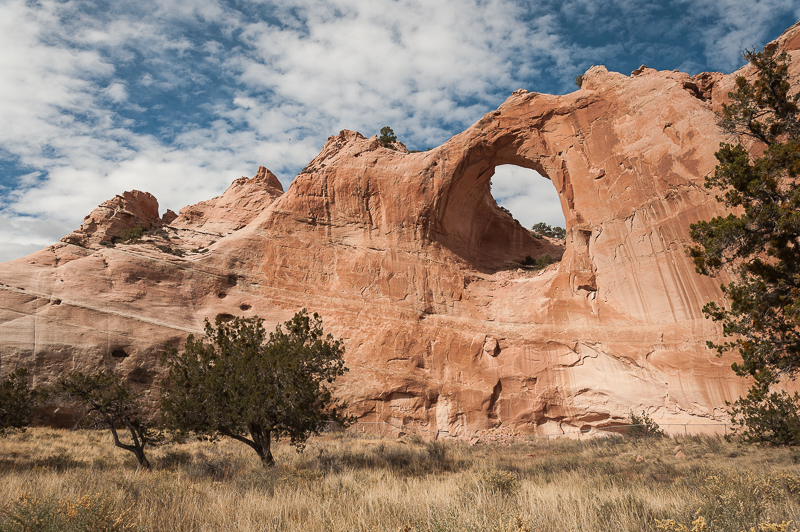
The capital of the Navajo Nation is located in Window Rock, Arizona, named for its famed natural feature. Photo: Ben FrantzDale
The Navajo Nation
Office of the President and Vice President
FOR IMMEDIATE RELEASE
March 29, 2021
Three branch chiefs hold initial discussion on the American Rescue Plan Act
WINDOW ROCK, Ariz. – On Monday, Speaker Seth Damon welcomed Navajo Nation President Jonathan Nez and Navajo Nation Chief Justice JoAnn B. Jayne to a three-branch chiefs discussion with the Naabik’íyáti’ Committee to discuss the $1.9 trillion American Rescue Plan Act, during a virtual work session hosted by the 24th Navajo Nation Council.
During the work session, the three branch chiefs spoke about the need to work together to implement the American Rescue Act funds. On March 11, U.S. President Joe Biden signed the American Rescue Plan Act into law, a $1.9 trillion relief package designed to help the United States recover from the devastating impacts of the ongoing COVID-19 pandemic. The Act provides $20 billion for tribes – $1 billion is to be allocated equally among the 574 federally recognized tribes while the U.S. Department of the Treasury will decide how the remaining funds will be distributed to tribes.
“The general strategy for the American Rescue Plan funds should be to maximize and leverage funding each of the funding opportunities, not only from the $20 billion, but also from the other pots of funding that will become available. We have been engaged in tribal consultation sessions with various federal agencies, regarding the American Rescue Plan. We are recommending that the funds be distributed as direct funding to tribes, and not in the form of grants that may require additional documentation and applications,” said President Nez.
He also spoke about the Nez-Lizer Administration’s work with the Biden-Harris Administration, congressional members, and federal agencies to advocate for a fair funding formula for federally-recognized tribes for the anticipated distribution of funding that was approved through the $1.9 trillion American Rescue Plan Act, President Nez also outlined general priorities related to direct relief, infrastructure development, economic recovery, housing, long-term planning, and more.
“Today’s discussion among the three branch chiefs helped lay the foundation for the Navajo Nation’s recovery beyond Covid-19. With funding coming to the Navajo Nation through the American Rescue Plan Act, we hope to see the best possible outcomes for the Navajo People. These funds will support many important infrastructure and recovery initiatives that will positively impact the health and wellbeing of our Nation’s citizens. At this critical point, we continue to advocate for a funding formula for Tribal Nations that uses enrollment data and other key conditions in the distribution of ARPA funds,” said Speaker Damon.
Chief Justice JoAnn B. Jayne said that the Judicial Branch is looking at immediate, midterm and long-term needs related to the COVID-19 public health emergency. She also reiterated that the Judicial Branch is interested in accessing other sources of funding to address the myriad issues the Navajo Nation faces in response to the pandemic, including Judicial Branch functions that address mental health services, prevention and treatment of substance abuse, veterans court services and support for older Americans. She noted that the Judicial Branch has been meeting with Public Safety to discuss prioritization of needs for judicial/public safety facilities. She further added that an assessment on how the CARES Fund money was spent by the Navajo Nation should be done to improve the processes in utilizing ARP funds.
The U.S. Treasury Department has not identified the amount that the Navajo Nation will be receiving, however, the Nez-Lizer Administration has recommended a funding formula based on four factors that include population, land base, number of employees, and direct COVID-19 impacts measured by coronavirus infections, deaths, and other key factors. President Nez also recommended that the Navajo Nation save its own funds, such as those from the Síhasin Fund and the Unreserved, Undesignated Fund Balance, and use the American Rescue Plan funds first.
“There were many lessons learned from the CARES Act that can be applied to the American Rescue Plan. We have to improve from the past and do better. We strongly recommend that we revisit CARES Act projects that were not previously completed due to the stringent deadlines included in the initial bill. The Navajo Nation’s Síhasin Fund remains, but the funds continue to be spent down at this point. Many, if not all of the current/ongoing Síhasin Fund projects should be leveraged with ARP funds. UUFB and other general funds should be saved if an ARP fund can be used instead,” added President Nez.
Among other funding, the American Rescue Plan also included direct stimulus payments of $1,400 for individuals, extends unemployment compensation, continues existing eviction and foreclosure moratoriums, funding for schools to mitigate COVID-19, and provides funds for COVID-19 testing and vaccinations.
https://www.facebook.com/NezLizer2018/posts/2750733048525554
HHS Small Ambulatory Program Awards $55 Million to 15 Tribes and Tribal Organizations (Indian Health Service)
Indian Health Service Announces New Deputy Director for Quality Health Care and Enterprise Risk Management (Indian Health Service)
Federal Emergency Management Agency (FEMA)
White House Office of Management and Budget (Joe Biden Administration)
Tuba City Regional Health Care Corporation (Arizona, Navajo Nation)
Oklahoma City Indian Clinic (OKCIC)
Indian Health Service (Department of Health and Human Services)
Navajo Nation Town Hall (Arizona, New Mexico, Utah)
Navajo Nation (Arizona, New Mexico, Utah)
Tribal organizations statement on advance appropriations for Indian Health Service
Indian Health Service Statement on Advance Appropriations (Department of Health and Human Services)
Indian Health Service (Department of Health and Human Services)
Indian Health Service (Department of Health and Human Services)
Navajo Nation (Arizona, New Mexico, Utah)
